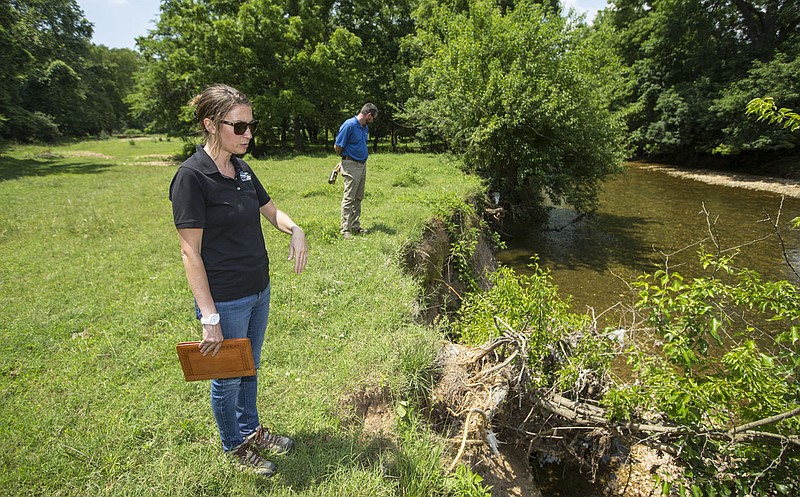SILOAM SPRINGS -- Twenty acres of Northwest Arkansas erodes into the Illinois River and its tributaries every year, people attending a conference on preserving the river's watershed learned Tuesday.
"Seventy percent of the inquiries we get from landowners are about stream bank stabilization," Leif Kindberg, executive director of the Illinois River Watershed Partnership, told the meeting. The partnership is a nonprofit group based in Cave Springs and dedicated to improving the quality of the watershed.
Kindberg was among the speakers at the first public meeting on updating the watershed-based management plan for the river.
The erosion problem is worse in Oklahoma, Shannon Phillips, director of the water quality division of the Oklahoma Conservation Commission, told the meeting. The watershed begins in Benton and Washington counties, going westward across the Oklahoma state line and through Tenkiller Lake to the Arkansas River.
Tuesday's meeting took place at the First Baptist Church in Siloam Springs. About 30 people attended. Plans for more public meetings will be scheduled and announced by the Natural Resources Division of the Arkansas Department of Agriculture and the Oklahoma Conservation Commission, representatives of those agencies told the gathering.
Revising the watershed management plan is expected to take a year to a year and four months, Phillips told the group. The watershed management plan draws up goals and recommendations for voluntary control of "nonpoint source" issues with water quality, such as erosion, livestock and poultry operations and stormwater runoff. "Point source" matters, such as wastewater treatment for cities and industry, are regulated by state agencies, such as the Arkansas Division of Environmental Quality.
The 20-acre figure derives from erosion studies at 15 different points in the watershed, Kindberg said. The partnership entered a contract with Natural State Streams LLC of Little Rock to study stream bank erosion. Natural State Streams is a private firm offering environmental consulting and mapping services and design for erosion control projects.
The report came out in September 2021, estimating that 102,822 tons of sediment erode into the river and its tributaries every year. Contributing factors to the soil loss include higher-than-normal rainfall in recent years; clearing of trees in the watershed; and harder, faster runoff as surfaces are paved or built over.
An estimated 54% of the phosphorus released into the upper portion of the watershed comes from erosion now, according to the study. Phosphorus levels in the river have been a cause of disagreement between Arkansas and Oklahoma for years. Phosphorus feeds blooms of algae that cloud the river and harm other forms of life in it. Efforts at removing chicken litter from the watershed and other sources have led to a steady drop in phosphorus levels over the years, but progress has plateaued, Tate Wentz, water quality section manager for the Arkansas Natural Resources Division, told the meeting.
One of the 15 sites selected for monitoring, the worst case, saw almost twice as much of its banks wash away as the other 14 sites combined, the study reported. The site involved is about half a mile north of where Arkansas 16 crosses the Illinois River, near the Savoy community. Measurements and aerial photography confirm the bank eroded by 135 feet "laterally," or deep, between May 2019 and and May 2020, the study said.
The dirt lost from that one site near Savoy from May 2019 to May 2020 amounts to 23,010 cubic yards, according to the study. In other words, enough to fill a sandbox 100 yards long, 50 yards wide, and more than four and a half yards deep. The erosion is so bad that, in the downstream one-third of the river bend there, "a large number of mature trees are becoming uprooted and entering the river, causing a significant log jam," the study found.
All through the watershed, efforts to control erosion or flooding in developed areas have caused problems in other areas, speakers at Tuesday's meeting said. For instance, some areas in the floodplain of the river were built up with enough fill dirt to allow construction, Kindberg said. That prevented the development from flooding, but hemmed in the flow of water in a nearby creek bed, increasing the speed and force of water going downstream during and after storms.
Awareness of the problems is growing among landowners and cities, speakers said. For instance, the city of Rogers is encouraging forms of low-impact development that allow more water to seep into the ground or flow out more slowly, speakers said.
On the web
Illinois River Watershed Partnership website:
irwp.org
Streambank Erosion Assessment Study summary, with link to the full report:
irwp.org/olc/sbe

